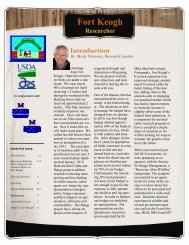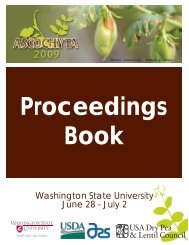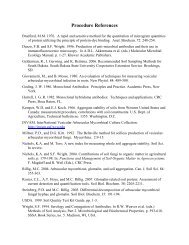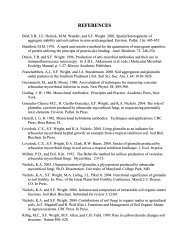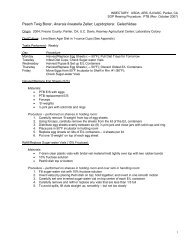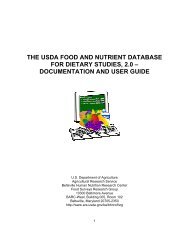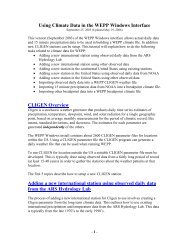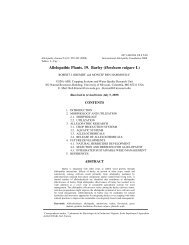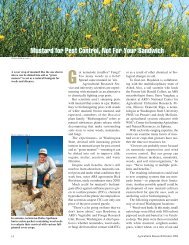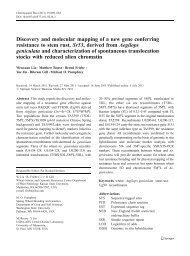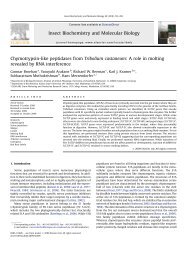- Page 1 and 2: CATALOG of SPECIES Fully Indexed [I
- Page 3 and 4: IMPORTANT NOTE Major new classifica
- Page 5: Table 2. Publications eliminating a
- Page 9 and 10: Accession numbers of strains from c
- Page 11 and 12: inTerpreTaTion of sTrain accession
- Page 13 and 14: transferred to DAOM. GCRI Horticult
- Page 15 and 16: Fungal Cultures Unidentified / Hyph
- Page 17 and 18: Fungal Cultures 9538 [SRCAMB VL-163
- Page 19 and 20: Fungal Cultures Unidentified sp. 32
- Page 21 and 22: Fungal Cultures Unidentified sp. 37
- Page 23 and 24: Fungal Cultures 9368 [ERL 1668] S G
- Page 25 and 26: Fungal Cultures Aschersonia sp. 409
- Page 27 and 28: Fungal Cultures 7394 M Liu (ml175-3
- Page 29 and 30: Fungal Cultures 7297 M Liu (FL02).
- Page 31 and 32: Fungal Cultures Aspergillus sp. [Eu
- Page 33 and 34: Fungal Cultures Aspergillus parasit
- Page 35 and 36: Fungal Cultures Basidiobolus merist
- Page 37 and 38: Fungal Cultures 5939 R Nelson (USF
- Page 39 and 40: Fungal Cultures Beauveria sp. 1204
- Page 41 and 42: Fungal Cultures Beauveria sp. 7564
- Page 43 and 44: Fungal Cultures 8166 LS Bauer and H
- Page 45 and 46: Fungal Cultures Beauveria bassiana
- Page 47 and 48: Fungal Cultures Beauveria bassiana
- Page 49 and 50: Fungal Cultures Beauveria bassiana
- Page 51 and 52: Fungal Cultures Beauveria bassiana
- Page 53 and 54: Fungal Cultures Beauveria bassiana
- Page 55 and 56: Fungal Cultures Beauveria bassiana
- Page 57 and 58:
Fungal Cultures Beauveria bassiana
- Page 59 and 60:
Fungal Cultures Beauveria bassiana
- Page 61 and 62:
Fungal Cultures Beauveria bassiana
- Page 63 and 64:
Fungal Cultures Beauveria bassiana
- Page 65 and 66:
Fungal Cultures Beauveria bassiana
- Page 67 and 68:
Fungal Cultures Beauveria bassiana
- Page 69 and 70:
Fungal Cultures Beauveria bassiana
- Page 71 and 72:
Fungal Cultures Beauveria bassiana
- Page 73 and 74:
Fungal Cultures Beauveria bassiana
- Page 75 and 76:
Fungal Cultures Beauveria bassiana
- Page 77 and 78:
Fungal Cultures Beauveria bassiana
- Page 79 and 80:
Fungal Cultures Beauveria bassiana
- Page 81 and 82:
Fungal Cultures Beauveria bassiana
- Page 83 and 84:
Fungal Cultures Beauveria bassiana
- Page 85 and 86:
Fungal Cultures Beauveria bassiana
- Page 87 and 88:
Fungal Cultures Beauveria bassiana
- Page 89 and 90:
Fungal Cultures Beauveria bassiana
- Page 91 and 92:
Fungal Cultures Beauveria bassiana
- Page 93 and 94:
Fungal Cultures Beauveria bassiana
- Page 95 and 96:
Fungal Cultures 10361 [ERL 563] BL
- Page 97 and 98:
Fungal Cultures Beauveria brongniar
- Page 99 and 100:
Fungal Cultures 6229 [RCEF 0231] Ad
- Page 101 and 102:
Fungal Cultures Cladosporium sphaer
- Page 103 and 104:
Fungal Cultures Conidiobolus sp. 14
- Page 105 and 106:
Fungal Cultures Conidiobolus corona
- Page 107 and 108:
Fungal Cultures Conidiobolus nr. co
- Page 109 and 110:
Fungal Cultures Conidiobolus thromb
- Page 111 and 112:
Fungal Cultures 4848 JM Sung (C-317
- Page 113 and 114:
Fungal Cultures Cordyceps militaris
- Page 115 and 116:
Fungal Cultures 5051 KT Hodge (kth3
- Page 117 and 118:
Fungal Cultures 2473 SP Frances (MI
- Page 119 and 120:
Fungal Cultures 4829 KT Hodge (kth2
- Page 121 and 122:
Fungal Cultures 2363 M Shimazu (F-5
- Page 123 and 124:
Fungal Cultures 765 BJ Martinell (4
- Page 125 and 126:
Fungal Cultures Entomophaga maimaig
- Page 127 and 128:
Fungal Cultures Entomophaga maimaig
- Page 129 and 130:
Fungal Cultures Entomophaga maimaig
- Page 131 and 132:
Fungal Cultures 3060 ME Ramos. Reis
- Page 133 and 134:
Fungal Cultures 6712 A Bruun Jensen
- Page 135 and 136:
Fungal Cultures 2507 J Eilenberg (K
- Page 137 and 138:
Fungal Cultures Evlachovaea sp. 664
- Page 139 and 140:
Fungal Cultures 5870 [Forest Pest M
- Page 141 and 142:
Fungal Cultures Fusarium sp. 4715 [
- Page 143 and 144:
Fungal Cultures Fusarium sp. 7233 G
- Page 145 and 146:
Fungal Cultures Fusarium niveum(?)
- Page 147 and 148:
Fungal Cultures 8927 [ERL 1543d] VS
- Page 149 and 150:
Fungal Cultures Hirsutella sp. Hirs
- Page 151 and 152:
Fungal Cultures Hirsutella citrifor
- Page 153 and 154:
Fungal Cultures Hirsutella kirchner
- Page 155 and 156:
Fungal Cultures Hirsutella satumaen
- Page 157 and 158:
Fungal Cultures Hypocrella javanica
- Page 159 and 160:
Fungal Cultures 9601 X Zou (8). Lar
- Page 161 and 162:
Fungal Cultures Isaria farinosa 350
- Page 163 and 164:
Fungal Cultures Isaria farinosa 567
- Page 165 and 166:
Fungal Cultures Isaria farinosa 711
- Page 167 and 168:
Fungal Cultures 9577 [ERL 1734] S G
- Page 169 and 170:
Fungal Cultures Isaria fumosorosea
- Page 171 and 172:
Fungal Cultures Isaria fumosorosea
- Page 173 and 174:
Fungal Cultures Isaria fumosorosea
- Page 175 and 176:
Fungal Cultures Maita, Colonia Urqu
- Page 177 and 178:
Fungal Cultures Lagenidium caudatum
- Page 179 and 180:
Fungal Cultures 10209 [ERL 1887] S
- Page 181 and 182:
Fungal Cultures 6888 H Cortez Madri
- Page 183 and 184:
Fungal Cultures Lecanicillium musca
- Page 185 and 186:
Fungal Cultures 8114 LS Bauer and H
- Page 187 and 188:
Fungal Cultures Lecanicillium psall
- Page 189 and 190:
Fungal Cultures 10194 [ERL 1872] S
- Page 191 and 192:
Fungal Cultures Metarhizium sp. 964
- Page 193 and 194:
Fungal Cultures Metarhizium sp. 972
- Page 195 and 196:
Fungal Cultures Metarhizium sp. 979
- Page 197 and 198:
Fungal Cultures Metarhizium sp. 987
- Page 199 and 200:
Fungal Cultures Metarhizium sp. 100
- Page 201 and 202:
Fungal Cultures Metarhizium sp. 100
- Page 203 and 204:
Fungal Cultures 10338 DW Roberts (D
- Page 205 and 206:
Fungal Cultures Metarhizium anisopl
- Page 207 and 208:
Fungal Cultures Metarhizium anisopl
- Page 209 and 210:
Fungal Cultures Metarhizium anisopl
- Page 211 and 212:
Fungal Cultures Metarhizium anisopl
- Page 213 and 214:
Fungal Cultures Metarhizium anisopl
- Page 215 and 216:
Fungal Cultures Metarhizium anisopl
- Page 217 and 218:
Fungal Cultures Metarhizium anisopl
- Page 219 and 220:
Fungal Cultures Metarhizium anisopl
- Page 221 and 222:
Fungal Cultures Metarhizium anisopl
- Page 223 and 224:
Fungal Cultures Metarhizium anisopl
- Page 225 and 226:
Fungal Cultures Metarhizium anisopl
- Page 227 and 228:
Fungal Cultures Metarhizium anisopl
- Page 229 and 230:
Fungal Cultures Metarhizium anisopl
- Page 231 and 232:
Fungal Cultures Metarhizium anisopl
- Page 233 and 234:
Fungal Cultures Metarhizium anisopl
- Page 235 and 236:
Fungal Cultures Metarhizium anisopl
- Page 237 and 238:
Fungal Cultures Metarhizium anisopl
- Page 239 and 240:
Fungal Cultures 2421 DG Holdom (050
- Page 241 and 242:
Fungal Cultures Metarhizium brunneu
- Page 243 and 244:
Fungal Cultures 1293 DW Roberts (H)
- Page 245 and 246:
Fungal Cultures 2140 T Searle (N).
- Page 247 and 248:
Fungal Cultures 7429 [CSIRO FI-0516
- Page 249 and 250:
Fungal Cultures Metarhizium taii ZQ
- Page 251 and 252:
Fungal Cultures Myriangium sp. [Dot
- Page 253 and 254:
Fungal Cultures Nomuraea rileyi 762
- Page 255 and 256:
Fungal Cultures Nomuraea rileyi 677
- Page 257 and 258:
Fungal Cultures Ophiocordyceps grac
- Page 259 and 260:
Fungal Cultures Paecilomyces sp. 35
- Page 261 and 262:
Fungal Cultures 7997 BC King (16).
- Page 263 and 264:
Fungal Cultures 6298 R Alatorre Ros
- Page 265 and 266:
Fungal Cultures 3094 M Wheeler. Emp
- Page 267 and 268:
Fungal Cultures Pandora neoaphidis
- Page 269 and 270:
Fungal Cultures Pandora neoaphidis
- Page 271 and 272:
Fungal Cultures 4144 [DAT 78] AC Ra
- Page 273 and 274:
Fungal Cultures Pseudogibellula for
- Page 275 and 276:
Fungal Cultures 8269 RJ Pereault (p
- Page 277 and 278:
Fungal Cultures 9385 CG Wilson (io9
- Page 279 and 280:
Fungal Cultures Simplicillium sp. [
- Page 281 and 282:
Fungal Cultures 9059 RW Lichtwardt
- Page 283 and 284:
Fungal Cultures 9036 RW Lichtwardt
- Page 285 and 286:
Fungal Cultures 6286 [RCEF 0264] [L
- Page 287 and 288:
Fungal Cultures 3392 CCFC (DAOM 180
- Page 289 and 290:
Fungal Cultures Hollow State Forest
- Page 291 and 292:
Fungal Cultures 9938 [ERL 1785] S G
- Page 293 and 294:
Fungal Cultures Verticillium lecani
- Page 295 and 296:
Fungal Cultures 6050 BL Parker (AT-
- Page 297 and 298:
Fungal Cultures Zoophthora radicans
- Page 299 and 300:
Fungal Cultures Zoophthora radicans
- Page 301 and 302:
Fungal Cultures Zoophthora radicans
- Page 303 and 304:
Fungal Cultures Zoophthora radicans
- Page 305 and 306:
Fungal Cultures Zoophthora radicans
- Page 307 and 308:
Host by Fungus Acremonium psammospo
- Page 309 and 310:
Host by Fungus 1211 1213 1214 1215
- Page 311 and 312:
Host by Fungus Beauveria bassiana [
- Page 313 and 314:
Host by Fungus Beauveria pseudobass
- Page 315 and 316:
Host by Fungus Dactylella sp. [Homo
- Page 317 and 318:
Host by Fungus Fusarium sp. [Acari:
- Page 319 and 320:
Host by Fungus Hirsutella thompsoni
- Page 321 and 322:
Host by Fungus Isaria tenuipes [Ara
- Page 323 and 324:
Host by Fungus Metarhizium anisopli
- Page 325 and 326:
Host by Fungus Spodoptera frugiperd
- Page 327 and 328:
Host by Fungus [Hymenoptera: Tenthr
- Page 329 and 330:
Host by Fungus Scopulariopsis sp. [
- Page 331 and 332:
Host by Fungus Trichoderma sp. [Hom
- Page 333 and 334:
Fungus by Host and Location Animali
- Page 335 and 336:
Fungus by Host and Location Coleopt
- Page 337 and 338:
Fungus by Host and Location Uzbekis
- Page 339 and 340:
Fungus by Host and Location Agriote
- Page 341 and 342:
Fungus by Host and Location Phyllop
- Page 343 and 344:
Fungus by Host and Location USA, Ma
- Page 345 and 346:
Fungus by Host and Location Culex r
- Page 347 and 348:
Fungus by Host and Location Hemipte
- Page 349 and 350:
Fungus by Host and Location Sterile
- Page 351 and 352:
Fungus by Host and Location Homopte
- Page 353 and 354:
Fungus by Host and Location Brazil,
- Page 355 and 356:
Fungus by Host and Location Coccus
- Page 357 and 358:
Fungus by Host and Location Hymenop
- Page 359 and 360:
Fungus by Host and Location Microce
- Page 361 and 362:
Fungus by Host and Location Rumania
- Page 363 and 364:
Fungus by Host and Location Lepidop
- Page 365 and 366:
Fungus by Host and Location Laspeyr
- Page 367 and 368:
Fungus by Host and Location Mariann
- Page 369 and 370:
Fungus by Host and Location Eumycot
- Page 371 and 372:
Geographical Origin 8558 8559 8563
- Page 373 and 374:
Geographical Origin Metarhizium ani
- Page 375 and 376:
Geographical Origin Zealand Acremon
- Page 377 and 378:
Geographical Origin Guyana Ascherso
- Page 379 and 380:
Geographical Origin Beauveria amorp
- Page 381 and 382:
Geographical Origin Pakistan Fusari
- Page 383 and 384:
Geographical Origin Nomuraea cylind
- Page 385 and 386:
Geographical Origin Unidentified /
- Page 387 and 388:
Geographical Origin USA 9155 9156 9
- Page 389 and 390:
Geographical Origin USA Beauveria b
- Page 391 and 392:
Geographical Origin USA Aschersonia
- Page 393 and 394:
Alternate Collections Abbott Labora
- Page 395 and 396:
Alternate Collections ARSEF 23 Meta
- Page 397 and 398:
Alternate Collections Banu, J. Guls
- Page 399 and 400:
Alternate Collections R-11 Marianna
- Page 401 and 402:
Alternate Collections 700.74 Metarh
- Page 403 and 404:
Alternate Collections 042 Metarhizi
- Page 405 and 406:
Alternate Collections 195 Metarhizi
- Page 407 and 408:
Alternate Collections CSIRO FI-0275
- Page 409 and 410:
Alternate Collections CSIRO FI-0871
- Page 411 and 412:
Alternate Collections DAT 134 Penic
- Page 413 and 414:
Alternate Collections DAT 37 Metarh
- Page 415 and 416:
Alternate Collections Devi, K. Uma
- Page 417 and 418:
Alternate Collections ERL 1731 Isar
- Page 419 and 420:
Alternate Collections 394 Isaria sp
- Page 421 and 422:
Alternate Collections Freimoser, Fl
- Page 423 and 424:
Alternate Collections Gouli, Vladim
- Page 425 and 426:
Alternate Collections HACC 190 Coni
- Page 427 and 428:
Alternate Collections Harrington, F
- Page 429 and 430:
Alternate Collections Huang, Bo 3-l
- Page 431 and 432:
Alternate Collections Hr 88 Hirsute
- Page 433 and 434:
Alternate Collections NCRI 170/02 I
- Page 435 and 436:
Alternate Collections 95010 Metarhi
- Page 437 and 438:
Alternate Collections Likhovidov, V
- Page 439 and 440:
Alternate Collections 111 Conidiobo
- Page 441 and 442:
Alternate Collections Myles, Tim G5
- Page 443 and 444:
Alternate Collections 47 Unidentifi
- Page 445 and 446:
Alternate Collections SPT-2-345 Pur
- Page 447 and 448:
Alternate Collections 8636 Zoophtho
- Page 449 and 450:
Alternate Collections Rath, Andrew
- Page 451 and 452:
Alternate Collections F359 Metarhiz
- Page 453 and 454:
Alternate Collections Roberts, Dona
- Page 455 and 456:
Alternate Collections Roberts, Dona
- Page 457 and 458:
Alternate Collections Ma Teetor S2
- Page 459 and 460:
Alternate Collections Ma5 Metarhizi
- Page 461 and 462:
Alternate Collections VLI/B-88 Leca
- Page 463 and 464:
Alternate Collections C-419 Polycep
- Page 465 and 466:
Alternate Collections Underwood, Na
- Page 467 and 468:
Alternate Collections C-1 Topo SP-3
- Page 469 and 470:
Alternate Collections HY268 Metarhi
- Page 471 and 472:
ARSEF Number 290 Beauveria bassiana
- Page 473 and 474:
ARSEF Number 809 Beauveria bassiana
- Page 475 and 476:
ARSEF Number 1254 Hirsutella citrif
- Page 477 and 478:
ARSEF Number 1710 Beauveria bassian
- Page 479 and 480:
ARSEF Number 2159 Aspergillus flavu
- Page 481 and 482:
ARSEF Number 2676 Beauveria bassian
- Page 483 and 484:
ARSEF Number 3131 Batkoa sp. 3132 C
- Page 485 and 486:
ARSEF Number 3556 Verticillium sp.
- Page 487 and 488:
ARSEF Number 4045 Isaria farinosa 4
- Page 489 and 490:
ARSEF Number 4490 Isaria fumosorose
- Page 491 and 492:
ARSEF Number 4950 Entomophaga macle
- Page 493 and 494:
ARSEF Number 5397 Entomophaga maima
- Page 495 and 496:
ARSEF Number 5822 Verticillium leca
- Page 497 and 498:
ARSEF Number 6244 Isaria cateniobli
- Page 499 and 500:
ARSEF Number 6669 Beauveria bassian
- Page 501 and 502:
ARSEF Number 7090 Clavicipitaceae a
- Page 503 and 504:
ARSEF Number 7516 Cordyceps brongni
- Page 505 and 506:
ARSEF Number 7937 Pandora neoaphidi
- Page 507 and 508:
ARSEF Number 8357 Metarhizium aniso
- Page 509 and 510:
ARSEF Number 8776 Metarhizium aniso
- Page 511 and 512:
ARSEF Number 9196 Beauveria bassian
- Page 513 and 514:
ARSEF Number 9637 Metarhizium sp. 9
- Page 515 and 516:
ARSEF Number 10057 Metarhizium sp.



